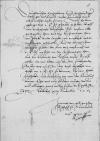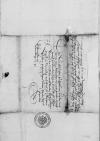 GStA PK, HBA, C1 No 807, 4v
GStA PK, HBA, C1 No 807, 4v
Dem durchlauchten, hochgebornen fursten und herren, hern ⌊Albrechten⌋, von Gots gnaden marggraff zu ⌊Brandenburg⌋, / in ⌊Preussen⌋, zu ⌊Stetin⌋, ⌊Pomern⌋, / der ⌊Cassuben⌋ und ⌊Wenden⌋ hertzog, / burggraff zu ⌊Normberg⌋ / und furst zu ⌊Rugenn⌋, / unserm hochgunstigen, lieben herren unnd freunde
 GStA PK, HBA, C1 No 807, 1r
GStA PK, HBA, C1 No 807, 1r
Durchlauchter, hochgeborner furst, hochgunstiger(r), lieber her und freundt. / Unsere freuntliche unnd vleiss willige dinste zuvorn. /
Wir habenn gestrigs tags E(wer) F(urstlichen) D(urchlauch)t ⌊⌋ erhalten, / doruff wir unbeschwert ⌊koniglicher m(aieste)t⌋, / unserm aller gnedigisten hern, / und dem hochwirdigen ⌊hern von Plotzka⌋ / under cantzler, / wie eingelegte ⌊⌋ mitbringen, geschrieben, / auch des betrieglichenn gewants halben / der form und weiss nach, / wie E(wer) F(urstliche) D(urchlauch)t anzeigt, / an den ⌊hochwirdigen hern⌋ / und die ⌊ersamen von Breslaw⌋ / unser brieffe geben, / die wir bitten mit den iren zuubersenden. / Es sein uns auch im dato diese beigelegte von hoffe an E(wer) F(urstlichen) D(urchlauch)t zukommen, / die wir hiebei zuschicken / mit erbietung, wo wir der freuntlich dienen, / ehre und nutz furdern mugen, / vordan und allwegen gantz willig zusein und geflissen. /
Dat(um) ⌊Heilsberg⌋, XVI Novembris 1541. /
⌊Ioannes⌋, von Gots gnaden bischoff zu ⌊Ermelandt⌋ /
ma(n)u p(ro)pria s(ub)s(cripsi)t



 GStA PK, HBA, C1 No 807, 4v
GStA PK, HBA, C1 No 807, 4v